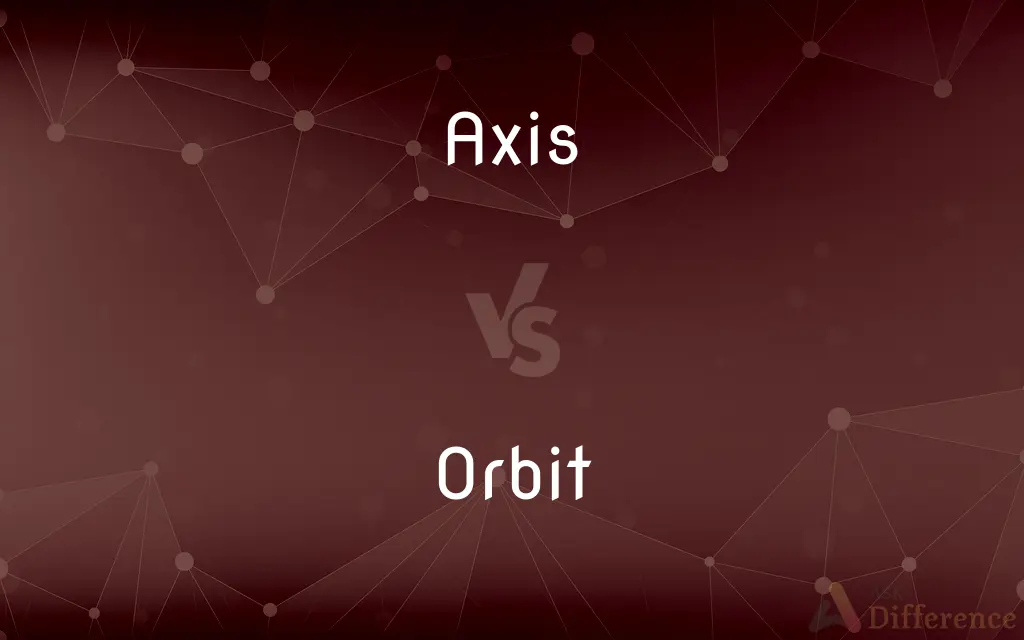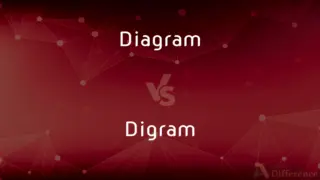Axis vs. Orbit — What's the Difference?
By Maham Liaqat & Urooj Arif — Updated on March 21, 2024
An axis is an imaginary line around which an object rotates, focusing on rotational motion, whereas an orbit is the path one object takes around another, emphasizing gravitational interaction.

Difference Between Axis and Orbit
Table of Contents
ADVERTISEMENT
Key Differences
An axis is an imaginary straight line around which an object, such as a planet, rotates. This rotation results in day and night cycles on Earth, for example. On the other hand, an orbit is the curved path that an object in space, like a planet or satellite, follows around another object due to gravitational forces, determining the length of a year on Earth as it orbits the Sun.
While the axis is central to understanding how objects spin and the orientation of that spin, orbits are essential for comprehending how objects in space move relative to each other over time. The Earth's tilt on its axis causes the seasonal variations we experience, whereas its elliptical orbit around the Sun leads to variations in distance from the Sun, affecting seasonal intensity.
The concept of an axis is more abstract, applicable not only to celestial bodies but also to shapes and forms in mathematics and physics, indicating points of rotation. Orbits, however, specifically describe the movement of celestial bodies under the influence of gravity, showcasing the interactions between different objects in space.
Axes can exist without gravity for example, an object spinning in space far from any gravitational pull will still rotate around an axis. Orbits, by contrast, are fundamentally tied to gravitational forces; without gravity, an object would not follow a curved path around another.
The study of axes involves understanding rotational dynamics, including angular velocity and momentum, which are crucial for engineering and physics. Studying orbits involves celestial mechanics and the laws of motion and gravitation, essential for space travel and understanding the universe's structure.
ADVERTISEMENT
Comparison Chart
Definition
Imaginary line an object rotates around.
Path an object follows as it moves around another.
Primary Focus
Rotational motion and orientation.
Gravitational interaction and trajectory.
Key Influences
Object's rotation speed and tilt.
Gravitational forces between objects.
Examples
Earth's rotation causing day and night.
Earth's path around the Sun defining a year.
Applicable Fields
Physics, engineering (rotational dynamics).
Celestial mechanics, astronomy (motion, gravitation).
Compare with Definitions
Axis
The central or principal structure around which something turns or is arranged.
The spindle is the axis of the wheel.
Orbit
A range or sphere of activity.
The discussion fell within the orbit of medical ethics.
Axis
An imaginary line about which a body rotates.
The Earth rotates on its axis once every 24 hours.
Orbit
The path of an electron around an atom's nucleus.
Electrons move in an orbit around the nucleus in distinct energy levels.
Axis
A fixed reference line for the measurement of coordinates.
The x-axis and y-axis form the basis of Cartesian coordinates.
Orbit
To move or travel around another object in a path shaped by gravity.
The satellite orbits the Earth every 90 minutes.
Axis
In anatomy, a central line of a body or part.
The axis vertebra enables the head to rotate.
Orbit
The curved path of a celestial object or spacecraft around a star, planet, or moon.
The Moon's orbit around the Earth takes about 27.3 days.
Axis
A straight line that divides a shape into two symmetrical parts.
The axis of symmetry in a circle runs through its center.
Orbit
In anatomy, the bony cavity containing the eyeball.
An orbital fracture can affect the bones of the eye's orbit.
Axis
A straight line about which a body or geometric object rotates or may be conceived to rotate.
Orbit
In physics, an orbit is the gravitationally curved trajectory of an object, such as the trajectory of a planet around a star or a natural satellite around a planet. Normally, orbit refers to a regularly repeating trajectory, although it may also refer to a non-repeating trajectory.
Axis
An unlimited line, half-line, or line segment serving to orient a space or a geometric object, especially a line about which the object is symmetric.
Orbit
The curved path of a celestial object or spacecraft round a star, planet, or moon, especially a periodic elliptical revolution
The Earth's orbit around the sun
Axis
A reference line from which distances or angles are measured in a coordinate system.
Orbit
An area of activity, interest, or influence
Audiences drawn largely from outside the Party orbit
Axis
A center line to which parts of a structure or body may be referred.
Orbit
The cavity in the skull of a vertebrate that contains the eye; the eye socket.
Axis
An imaginary line to which elements of a work of art, such as a picture, are referred for measurement or symmetry.
Orbit
(of a celestial object or spacecraft) move in orbit round (a star or planet)
Mercury orbits the Sun
Axis
The second cervical vertebra on which the head turns.
Orbit
The path of a celestial body or an artificial satellite as it revolves around another body due to their mutual gravitational attraction.
Axis
Any of various central structures, such as the spinal column, or standard abstract lines used as a positional referent.
Orbit
One complete revolution of such a body.
Axis
(Botany) The main stem or central part about which organs or plant parts such as branches are arranged.
Orbit
The path of a body in a field of force surrounding another body; for example, the movement of an atomic electron in relation to a nucleus.
Axis
One of three mutually perpendicular lines that define the orientation of an aircraft, with one being along its direction of travel and the other two being perpendicular to the direction of travel.
Orbit
A range of activity, experience, or knowledge.
Axis
A line through the optical center of a lens that is perpendicular to both its surfaces.
Orbit
A range of control or influence
"What magnetism drew these quaking ruined creatures into his orbit?" (Malcolm Lowry).
Axis
One of three or four imaginary lines used to define the faces of a crystal and the position of its atoms.
Orbit
Either of two bony cavities in the skull containing an eye and its external structures. Also called eye socket.
Axis
An alliance of powers, such as nations, to promote mutual interests and policies.
Orbit
To move in an orbit.
Axis
Axis The alliance of Germany and Italy in 1936, later including Japan and other nations, that opposed the Allies in World War II.
Orbit
To revolve around (a center of attraction)
The moon orbits Earth.
Axis
(geometry) An imaginary line around which an object spins (an axis of rotation) or is symmetrically arranged (an axis of symmetry).
The Earth rotates once a day on its axis
Orbit
To put into an orbit
The space agency orbited a new satellite.
Axis
(mathematics) A fixed one-dimensional figure, such as a line or arc, with an origin and orientation and such that its points are in one-to-one correspondence with a set of numbers; an axis forms part of the basis of a space or is used to position and locate data in a graph (a coordinate axis)
Orbit
(astronomy) A circular or elliptical path of a celestial object or spacecraft around a star, planet, moon, or Lagrange point, especially a periodic elliptical revolution.
Axis
(skeleton) The second cervical vertebra of the spine
Orbit
One complete circuit round an orbited body.
The Moon's orbit around the Earth takes nearly one month to complete.
Axis
(anatomy) An imaginary, visualized plane separating two morphologically similar parts of an organism
Orbit
(uncountable) The state of moving in an orbit.
Axis
(psychiatry) A form of classification and descriptions of mental disorders or disabilities used in manuals such as the DSM (Diagnostic and Statistical Manual of Mental Disorders)
Orbit
(physics) The path of an electron around an atomic nucleus.
Axis
(botany) The main stem or central part about which organs or plant parts such as branches are arranged
Orbit
(pinball) A path for the ball on the outer edge of the playfield, usually connected so that the ball entering in one end will come out of the other.
Axis
(military) An alliance or coalition.
Orbit
A sphere of influence; an area or extent of activity, interest, or control.
In the post WWII era, several eastern European countries came into the orbit of the Soviet Union.
The convenience store was a heavily travelled point in her daily orbit, as she purchased both cigarettes and lottery tickets there.
Axis
A deer native to Asia, of species Axis axis.
Orbit
(anatomy) The bony cavity in the skull of a vertebrate containing the eyeball.
Axis
The spotted deer (Cervus axis or Axis maculata) of India, where it is called hog deer and parrah (Moorish name).
Orbit
(zoology) The area around the eye of a bird or other animal.
Axis
A straight line, real or imaginary, passing through a body, on which it revolves, or may be supposed to revolve; a line passing through a body or system around which the parts are symmetrically arranged.
Orbit
(mathematics) A collection of points related by the evolution function of a dynamical system. Category:en:Curves
Axis
A straight line with respect to which the different parts of a magnitude are symmetrically arranged; as, the axis of a cylinder, i. e., the axis of a cone, that is, the straight line joining the vertex and the center of the base; the axis of a circle, any straight line passing through the center.
Orbit
The subset of elements of a set X to which a given element can be moved by members of a specified group of transformations that act on X.
Axis
The stem; the central part, or longitudinal support, on which organs or parts are arranged; the central line of any body.
Orbit
(informal) A state of increased excitement, activity, or anger.
Dad went into orbit when I told him that I'd crashed the car.
Axis
The second vertebra of the neck, or vertebra dentata.
Orbit
(astronomy) To circle or revolve around another object or position.
The Earth orbits the Sun.
The satellite orbits the Lagrange point.
Axis
One of several imaginary lines, assumed in describing the position of the planes by which a crystal is bounded.
Orbit
To place an object (e.g. a satellite) into an orbit around a planet.
A rocket was used to orbit the satellite.
Axis
The primary or secondary central line of any design.
Orbit
To move around the general vicinity of something.
The harried mother had a cloud of children orbiting her, begging for sweets.
Axis
A straight line through a body or figure that satisfies certain conditions
Orbit
To move in a circle.
Axis
The center around which something rotates
Orbit
(transitive) To center (around).
Axis
The main stem or central part about which plant organs or plant parts such as branches are arranged
Orbit
To continue to follow and/or engage with someone via social media after breaking up with them.
Axis
In World War II the alliance of Germany and Italy in 1936 which later included Japan and other nations;
The Axis opposed the Allies in World War II
Orbit
The path described by a heavenly body in its periodical revolution around another body; as, the orbit of Jupiter, of the earth, of the moon.
Axis
A group of countries in special alliance
Orbit
An orb or ball.
Roll the lucid orbit of an eye.
Axis
The 2nd cervical vertebra; serves as a pivot for turning the head
Orbit
The cavity or socket of the skull in which the eye and its appendages are situated.
Orbit
The skin which surrounds the eye of a bird.
Orbit
The (usually elliptical) path described by one celestial body in its revolution about another;
He plotted the orbit of the moon
Orbit
A particular environment or walk of life;
His social sphere is limited
It was a closed area of employment
He's out of my orbit
Orbit
An area in which something acts or operates or has power or control:
The range of a supersonic jet
The ambit of municipal legislation
Within the compass of this article
Within the scope of an investigation
Outside the reach of the law
In the political orbit of a world power
Orbit
The path of an electron around the nucleus of an atom
Orbit
The bony cavity in the skull containing the eyeball
Orbit
Move in an orbit;
The moon orbits around the Earth
The planets are orbiting the sun
Electrons orbit the nucleus
Common Curiosities
What factors influence the shape of an orbit?
The primary factors are the gravitational pull of the bodies involved and the initial speed and direction of the orbiting object.
What is axial precession?
Axial precession is the gradual shift in the orientation of an astronomical body's axis of rotation over time.
How does Earth's axis affect climate?
Earth's axial tilt causes the seasonal variations by changing the distribution of sunlight received at different times of the year.
Is the axis of rotation in space always fixed?
The axis of rotation can shift due to external forces, such as gravitational influences from other celestial bodies, a phenomenon known as precession.
What determines the direction of an object's orbit?
The direction is primarily determined by the object's initial velocity and the gravitational forces acting upon it.
What is the significance of synchronous orbits?
In a synchronous orbit, an object orbits at a rate that matches the rotation of the body it orbits, leading to it always facing the same side of the planet.
Can the axis of a planet change suddenly?
Sudden changes are rare but can occur due to significant impacts or gravitational interactions.
What role does mass play in orbits?
Mass affects the gravitational pull between objects, influencing the shape and stability of orbits.
Can an object have multiple axes?
Yes, an object can rotate around multiple axes, especially if it's part of a complex system or mechanism.
Why are orbits generally elliptical?
According to Kepler's laws of planetary motion, orbits are elliptical due to the way gravitational forces work and how objects move faster when closer to the body they are orbiting.
How do satellites maintain their orbits?
Satellites maintain their orbits through a balance of gravitational pull and their initial velocity, with adjustments made through thrusters if necessary.
How is the axis of rotation measured?
It's often described in terms of angle relative to a reference, such as the tilt of Earth's axis relative to its orbital plane around the Sun.
Can orbits change over time?
Yes, orbits can change due to gravitational interactions with other objects, such as other planets or stars.
What is the difference between geostationary and geosynchronous orbits?
Geostationary orbits are a type of geosynchronous orbit where the satellite remains over the same point on the Earth's surface, whereas geosynchronous orbits have a period that matches Earth's rotation but can move across the sky from the ground's perspective.
Why do comets have highly elliptical orbits?
Comets have highly elliptical orbits because they are greatly influenced by the Sun's gravity when they come close, speeding up and then slowing down as they move away.
Share Your Discovery

Previous Comparison
Diagram vs. Digram
Next Comparison
Exempted vs. ExemptAuthor Spotlight
Written by
Maham LiaqatCo-written by
Urooj ArifUrooj is a skilled content writer at Ask Difference, known for her exceptional ability to simplify complex topics into engaging and informative content. With a passion for research and a flair for clear, concise writing, she consistently delivers articles that resonate with our diverse audience.
















































